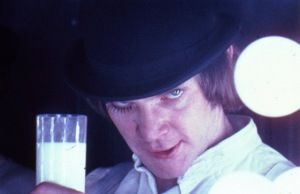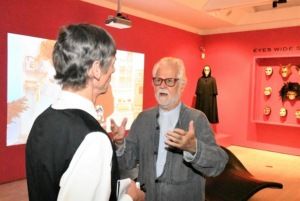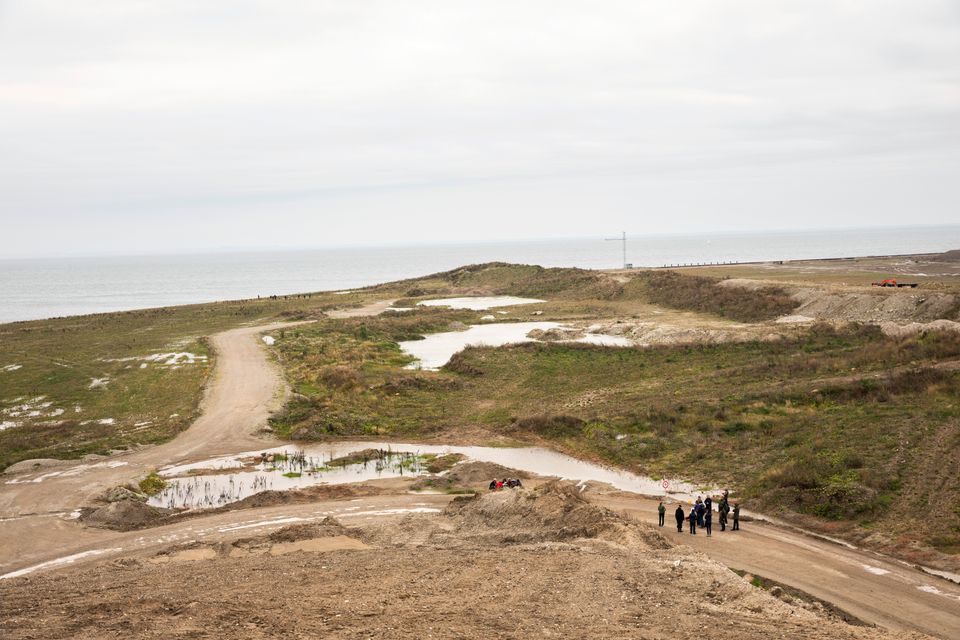In a career lasting around 48 years, Kubrick only made 16 films, so he can hardly be called prolific. However, film critics rightly consider nearly all of these to be milestones of cinema.
Spread over three floors, the exhibition has been designed to illuminate all aspects of the American director’s work. It contains photos, costumes, models, scripts, reference materials – as well, of course, as screens showing clips from all his major films.
A precocious youngster
Kubrick started his career aged 13, when he was given a camera as a present. He taught himself to be a photographer and was soon selling pictures to magazines. The first room has a selection of his work, mainly for ‘Look’ magazine.
That Kubrick had a keen visual eye is already apparent here. There is a striking image of Frank Sinatra taken in 1950, shot slightly upwards through the angle formed by a person in the foreground’s torso and outstretched arm that forms a dark ‘A’, framing the singer, who is looking directly into the camera.
Around this time his fascination with the world of boxing also began to emerge. He made a short film on the subject, ‘Day of the Fight’, in 1951.
Trouble with the censors
Kubrick’s first major Hollywood effort was the noirish ‘The Killing’, and it did quite well at the box office. After that, he went on to work with Kirk Douglas on the World War I picture ‘Paths of Glory’ and then, at Douglas’s instigation, stepped in to replace Anthony Mann on ‘Spartacus’.
‘Paths of Glory’ caused considerable controversy when it came out – especially in France where it was regarded as an insult to the French army and was banned until 1975.
As if that was not enough, his next project, ‘Lolita’, was potentially even more incendiary in the straight-laced atmosphere of early-1960s America.

Kubrick was right to worry about the censors. Despite making the girl who played Lolita slightly older than she was in Nabokov’s book, the US National Legion of Decency gave the film a ‘condemned’ rating, which meant that it would be a sin for a good Catholic to see it.
The first floor ends with drawings and other material from the coal-black comedy ‘Dr Strangelove – or how I learned to stop worrying and love the atomic bomb’. A tour-de-force from actor Peter Sellers, who plays multiple roles, it is still considered one of cinema’s best comedies. Kubrick said of it: “Most of the humour in Dr Strangelove arises from the depiction of everyday human behaviour in a nightmarish situation.”
A triumph of special effects
The second floor starts with ‘2001 – a Space Odyssey’, where one of the suits worn by the primitive humanoids featured at the beginning of the film is on display, along with the spacesuit worn by astronaut Dave Bowman.
“I tried to create a visual experience: one that bypasses verbalised pigeon-holing and directly penetrates the sub-conscious with emotional and philosophical content,” said Kubrick of the film. There are also exhibits explaining how the breathtaking special effects for ‘2001’ were created. As an interesting aside, in 1985 NASA named its space shuttle ‘Discovery’ as a tribute to Bowman’s spaceship in the film ‘2001’.
The material on display from ‘A Clockwork Orange’ includes some of the costumes worn by Malcolm McDowell as the psychopathic Beethoven-loving gang leader Alex DeLarge. There are also a couple of the plastic tables from the milk bar frequented by the gang shaped like naked girls, which are very reminiscent of the work of the contemporary English pop artist Allan Jones.

Needless to say, the film got Kubrick into trouble with the censors again. In the UK, Warner Brothers withdrew it from release in 1973, at the director’s own request; only after his death did the film again became widely available.
A visual feast
One of the most visually exquisite films ever made, ‘Barry Lyndon’ was a complete change of direction. Kubrick totally immersed himself in the world of the 18th century, studying a great many books and contemporary art. He also filmed all the interior scenes in candlelight to create the right ambience. In this he was extremely fortunate that Ziess had just developed a new lens that enabled shooting in low lighting conditions. The exhibition has some of the thousands of costumes produced for the film, as well as one of the cameras used, fitted with the famous lens.
There is a great deal more to see – for example, material from ‘The Shining’ (a model of the maze, Jack’s Torrance’s typewriter and the famous fire axe, among other things), ‘Full Metal Jacket’ (Joker’s helmet, glasses and Mickey Mouse watch) and ‘Eyes Wide Shut’.

There is also ‘what if?’ material relating to projects that never came to fruition, such as a projected film about Napoleon. Here, a selection of the books on Napoleon that Kubrick amassed is included – plus a giant card index recording Napoleon’s almost every move; Kubrick was nothing if not thorough.
Several of Kubrick’s films were under-appreciated on release, but over the years they have grown in stature. Like all great artists, he was perhaps ahead of his time. If you are unfamiliar with Kubrick’s work, go. If you do, I can almost guarantee you’ll want to go and investigate his films afterwards.
Finally, for anyone who wants to dig a little deeper, there is a profusely-illustrated catalogue to accompany the exhibition for a price of 225 kroner.














